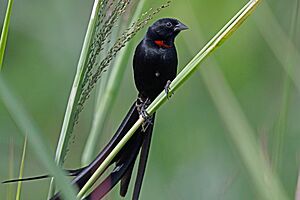Red-collared widowbird facts for kids
Quick facts for kids Red-collared widowbird |
|
|---|---|
 |
|
| Male in breeding plumage | |
| Conservation status | |
| Scientific classification | |
| Genus: |
Euplectes
|
| Species: |
ardens
|
The red-collared widowbird (Euplectes ardens) is a type of bird that belongs to the Ploceidae family. These birds live in grasslands and open areas in western and southern Africa. They are famous for their long tails and bright red chest patches. These features help them attract mates.
Red-collared widowbirds often live near other widowbird and bishop species. Males of this species can have many female partners, a system called polygyny. For males, having a good territory is key to finding mates. The red-collared widowbird is found in many places, so it is not currently considered an endangered species.
Contents
About the Red-collared Widowbird
The red-collared widowbird got its scientific name, Euplectes ardens, from a Dutch scientist named Pieter Boddaert in 1783. The name Euplectes comes from Ancient Greek words meaning "fine" or "good" and "weaver." This refers to how these birds build their nests. The word ardens is Latin for "burning" or "glowing," which describes the male's bright red color.
Scientists used to think that all widowbirds were closely related. However, new studies show that the red-collared widowbird might be more like a "long-tailed bishop" than a true widowbird. In zoos, these birds have even had babies with other bird species like the southern red bishop.
What Do Red-collared Widowbirds Look Like?
Red-collared widowbirds show big differences between males and females, and also between seasons. This is called sexual dimorphism.
- Males: During the breeding season (October to April), male red-collared widowbirds are about 25 centimeters (10 inches) long. They have shiny black feathers and a very long tail, which can be about 22 centimeters (9 inches) long. They also have a bright, crescent-shaped red patch on their chest. This red color comes from pigments called carotenoids. When it's not breeding season, males lose their bright colors and look dull brown, but they keep their black tails.
- Females and Young Birds: Females are smaller, only about 13 centimeters (5 inches) long. They weigh less too. Females and young birds are mostly streaky dull brown with short, dark-brown tails, about 4 centimeters (1.5 inches) long.
Where Do They Live?
Red-collared widowbirds live across Eastern and Southern Africa. They can be found in many different places. You might see them in open grasslands, farm areas, clearings in forests, and on hillsides with few trees.
How Red-collared Widowbirds Live
What Do They Eat?
Red-collared widowbirds mainly eat seeds from grasses, like sorghum. They also enjoy nectar from flowers, small berries, and insects. Their favorite insects include ants, caterpillars, and termites.
These birds often gather in large groups, called roosts, with 50 to 100 birds. They feed together on the ground. Sometimes, they even join other bird species like red-billed quelea and southern red bishop to feed.
Reproduction and Family Life
Male red-collared widowbirds do not help raise their babies. They only provide a good spot for the nest in their territory. Females build the actual nests, which are usually oval-shaped and lined with grass.
Females lay between 2 and 4 eggs. The eggs are usually grayish or blue-green with brown spots. The mother bird sits on the eggs for 12 to 15 days until they hatch. She also feeds the chicks by herself for about 14 to 17 days, often by bringing up food from her stomach. Sometimes, other birds like Diederik cuckoos lay their eggs in the widowbirds' nests, making the widowbirds raise their chicks.
Because males don't help with raising young, it's very important for them to claim a good territory. They fight hard to protect their territory from other males. Females choose males based on the quality of their territory.
Special Features: Tails and Feathers
Male red-collared widowbirds have two main features that help them attract mates and compete with other males: their long tails and their bright red chest patches.
Long Tails
Before the breeding season, males grow new, longer tail feathers. The longer a male's tail is, the more successful he is at finding mates. Females seem to prefer males with longer tails. This long tail is a "costly" feature because it makes flying harder and uses a lot of energy. This shows females that the male is strong and healthy.
Bright Red Feathers
The red patch on the male's chest is very bright. This color comes from special pigments in their food, mostly grass seeds. The red collar is mostly used for competition between males. Studies have shown that males with brighter, larger red patches are more dominant. They are better at defending their territories and have fewer other males trying to invade. This means the red collar signals a male's strength and fighting ability to other males.
So, the long tail helps males attract females, while the red chest patch helps them win fights against other males for territory. Both are important for a male's success.
Conservation Status
Red-collared widowbirds are not considered to be in danger. They live in a very large area and are common in many places. For example, there are about 2,000 of them in Kruger National Park in South Africa. Around 11,000 individuals live in South and Central Mozambique.
Images for kids



